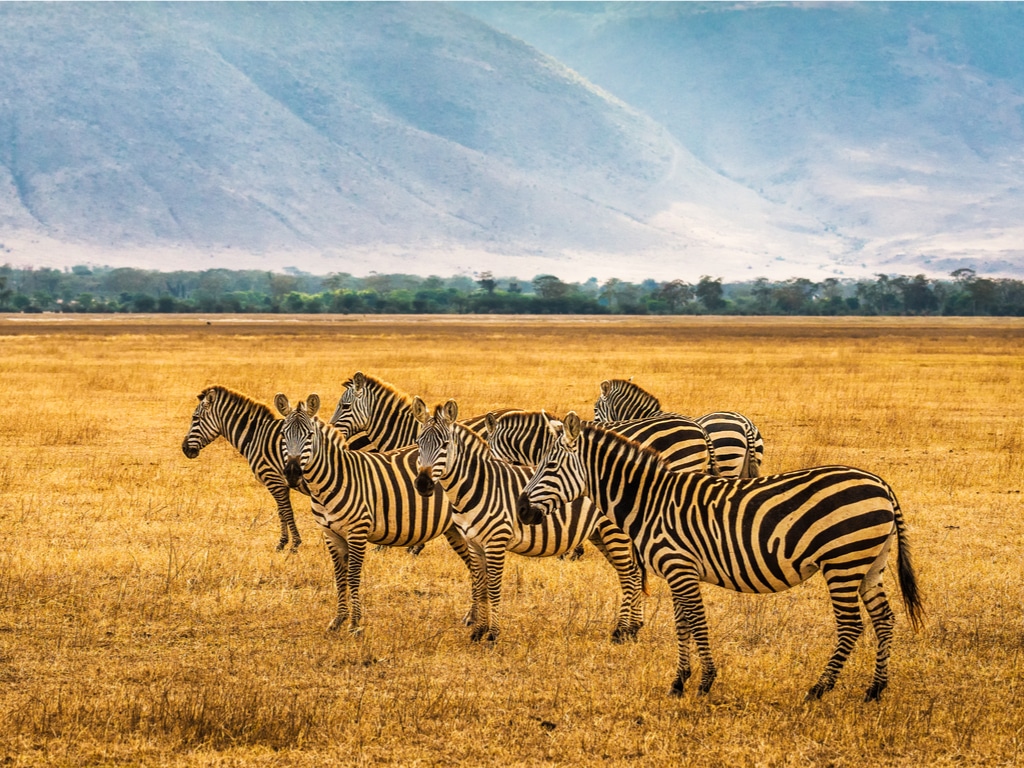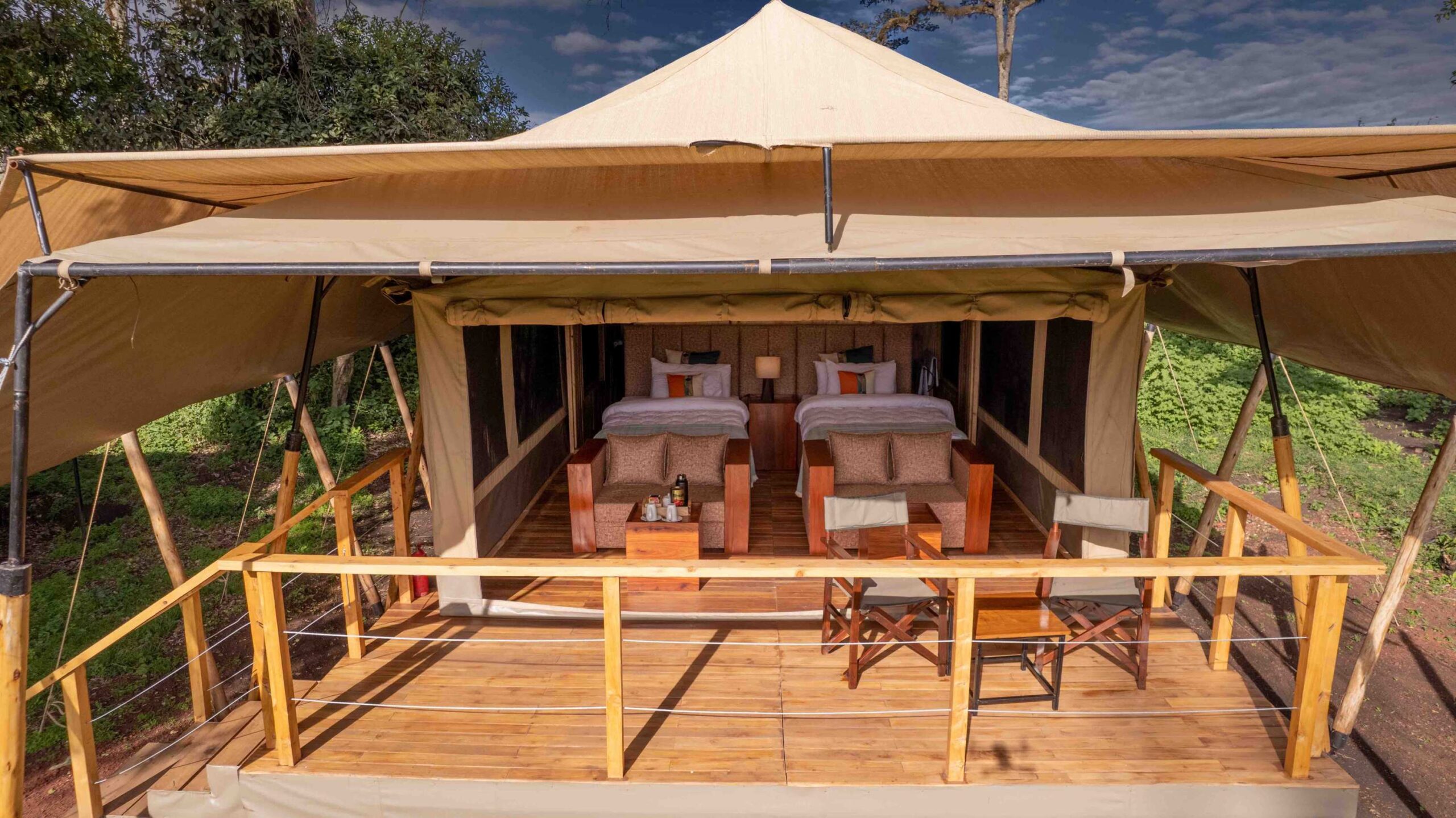Ngorongoro conservation Area.
Ngorongoro conservation area is a protected and a UNESCO World Heritage Site located in northern Tanzania. Ngorongoro conservation area covers an area of 8288 square kilometers and it is a home to the famous Ngorongoro Crater, the largest intact caldera in the world, which was formed around 2.5 million years ago. Ngorongoro conservation area is a massive safari destination to go on a safari in Tanzania. It is part of the Serengeti ecosystem, and Ndutu region is where this conservation area and the southern part of Serengeti national park meet. Serengeti national park is right next to the Ngorongoro conservation area. Ngorongoro conservation area is 50 kilometres from Lake Manyara national park, 139 kilometres from Tarangire national park, and 213 kilometres from Arusha national park. The area is characterized by diverse landscapes, including forests, grasslands, and mountains and is inhabited by over 25,000 large animal species like the Big five (lions, elephants, buffaloes, leopards and rhinos) as well as incredible variety of bird species that are over 500 bird species. Ngorongoro conservation area is also a home to several indigenous tribes, including the Maasai, who coexist with wildlife in a unique example of conservation and human wildlife coexistence.

Attractions in Ngorongoro conservation area.
Animal species.
Ngorongoro reserve area is a home to an incredible variety of animal species with over 25,000 large animal species inhabiting the area. The Big Five includes lions, leopards, buffaloes, rhinos and elephnats along with other incredible species such as cheetahs, hyenas, giraffes, zebras and among many others. Ngorongoro conservation area is also a habitat for several endangered species, like black rhinoceros, African wild dogs and hippopotamuses. The crater floor, in particular is a haven for wildlife, with its lush grasslands and water sources attracting a wide variety of animals making Ngorongoro Conservation area one of the Africa’s most spectacular and diverse wildlife safari destinations.
Bird species.
Ngorongoro conservation area is a haven for the birdwatchers, with over 500 species of bird species recorded within the area, the crater floor, with its diverse habitats, such as grasslands, forests and wetlands, supports an incredible variety of birdlife such as residents and migratory bird species such as ostriches, secretary birds, kori bustards, crowned cranes and among many others. The area is also a home to numerous species of raptors such as eagles, hawks, falcons, and vultures as well as a wide variety of water birds like flamingos, pelicans and storks. The Ngorongoro Conservation Area’s unique location, is situated near the equator and at the intersection of several migratory routes, makes it an important stopover point for many bird species, offering a truly spectacular and diverse birdwatching safari experience.
Ngorongoro Crater.
Ngorongoro crater is located within the Ngorongoro conservation area in Tanzania, is the world’s largest intact caldera, formed around 2.5 million years ago when a massive volcano collapsed in on itself. The crater, measures approximately 260 square kilometers in size and 610 meters deep, is a self-contained ecosystem that supports an incredible variety of wildlife including the big five mammals and among others. The crater floor, is covered in grasslands, forests and wetlands, is also a home to several lakes, rivers and waterfalls and surrounded by steep walls that rise up to 610meters, creating a natural amphitheater that offers breathtaking views and a unique wildlife safari experience. Other safari attractions in Ngorongoro conservation area includes Olduvai Gorge, Laetoli Footprints, Empakai crater, Lake Ndutu, Lake Magadi, Ngorongoro Highlands and among others.
Safari activities to do in Ngorongoro conservation area.
Game drive.
Game drives in Ngorongoro conservation area offer a thrilling and unforgettable safari experience, allowing the visitors to experience the area’s diverse landscapes and witness its incredible variety of wildlife. During the game drives you can see animals like the big five mammals and other animal species like hyenas, giraffes, zebras and among many others in the Ngorongoro conservation area by taking a 4X4 vehicle down through the lush forests to the crater floor. Game viewing sessions include a morning game drive, a full-day game drive, afternoon game drive and a night game drive. The morning game drive is the best time to see big cats like lions and leopards hunting for food. The night game drive is great for seeing predators like lions, leopards, and wild dogs with the help of a spotlight. The guided drives can be led by the experienced and knowledgeable guides that take visitors through the best spots and surrounding areas, providing opportunities to spot wildlife in their natural habitat.
Bird watching.
Ngorongoro conservation area is a birdwatcher’s safari destination on a Tanzania birding safari. It is home to more than 500 bird species, the conservation area’s diverse landscapes like grasslands, forests, wetlands and lakes provide a habitat for a wide range of bird species from water bird species such as flamingos, storks, pelicans and vultures and colorful birds like lilac-breasted roller, bee-eaters and sun-birds. The crater floor, with its unique geography and climate is a home to several endemic species, like Ngorongoro pipit and the Rufous-tailed weaver, while the surrounding highlands and forests support a variety of montane and forest bird species. Guided bird walks and game drives, led by experienced guides, offer visitors the opportunity to spot and learn about the area’s incredible birdlife.
Walking safaris.
Ngorongoro conservation area is intriguing destination for Tanzania walking safaris, this is a unique and exhilarating way to experience the area’s stunning natural beauty and incredible wildlife. The experience can be guided by experienced and knowledgeable guides to the conservation area’s diverse landscapes like grasslands, forests, wetlands, crater rim walks, hikes to the Empakaai crater, climbs up the sides of the Olmoti volcano, walking safaris provide the opportunity to get up close and personal wildlife like large mammals like elephnats, buffaloes, antelopes as well as smaller creatures like birds, reptiles, insects and among others. Along the way, guides share their knowledge of the area’s geology, history and wildlife, providing a nature understanding and appreciation of this incredible ecosystem.
Archaeological tours.
Archaeological tours in Ngorongoro conservation area offer a fascinating experience into the area’s rich human history, which spans over 4 million years. Visitors can explore the famous Olduvai Gorge, a UNESCO World Heritage Site, where Leakey family discovered the earliest human fossils, including the 3.6 million-year-old footprints of early humans. Guided tours led by experienced guides and archaeologists offer information of the history of human evolution, the discovery of early stone tools and the development of early human societies. The tours also visit other archaeological sites, such as Laetoli, where the famous footprints of early humans were discovered and the Ngorongoro Highlands, where ancient rock art and artifacts can be found. By exploring these sites, visitors can gain the real understanding off the area’s history and the significance of the Ngorongoro conservation area as a cradle of humanity.
Where to stay in Ngorongoro conservation area.
Accommodation in Ngorongoro conservation area is available in an extensive variety of lodges and camps which are offered in 3 status that are Luxury, midrange and Budget. Accommodation in Ngorongoro conservation area include Ngorongoro crater lodge, Lemala Ngorongoro Tented camp, Ngorongoro Spa Lodge, Serena Ngorongoro Lodge, Ang’ata Ngorongoro camp, Neptune Ngorongoro Luxury lodge, Lion’s paw cam, Ngorongoro Forest Tented lodge, Hhando coffee lodge, Ngorongoro wildlife lodge, Ngorongoro Rhino lodge, Ngorongoro Oldeani Mountain Lodge and many more.

Best time to visit Ngorongoro Conservation Area.
Ngorongoro Conservation Area is an excellent safari destination all the year round, but the best time to visit depends on what you are looking for. The dry season from June to October is the best for classic wildlife viewing. During this period the grass on the crater flor is short and the animals are easier to spot as they gather around the few water sources. For a more scenic experience with fewer tourists consider wet season from November to May. The landscape is lush and green, and birdwatching is at its peak. January and February are especially good for seeing the wildebeest and zebra herds with their newborn calves on the plains.
How to get to Ngorongoro conservation area.
Getting to Ngorongoro conservation area can be accomplished using air and road means of transport, Ngorongoro conservation area is situated in in a distance of about 173 kilometers from Arusha a prominent tourism city in Tanzania. From the city of Arusha, you can drive to Loduare Gate, which is near the town of Karatu. There are also ways to get to Ngorongoro Conservation Area from places like Serengeti National Park, Lake Manyara National Park, and many others on the northern safari tour.
By air, you can get to Ngorongoro Conservation Area on direct flights or local chartered flights. You can also take direct flights to the Kilimanjaro International Airport, which is 46 kilometres away and is the gateway to the town of Arusha. From Kilimanjaro International Airport, you can take a local flight to either the Ngorongoro or Lake Ndutu airstrips. Air Tanzania, Precision Air, Regional Air, Zan Air, Safari Air Link, and Coastal Aviation all offer domestic chartered trips to Ngorongoro Conservation Area.

